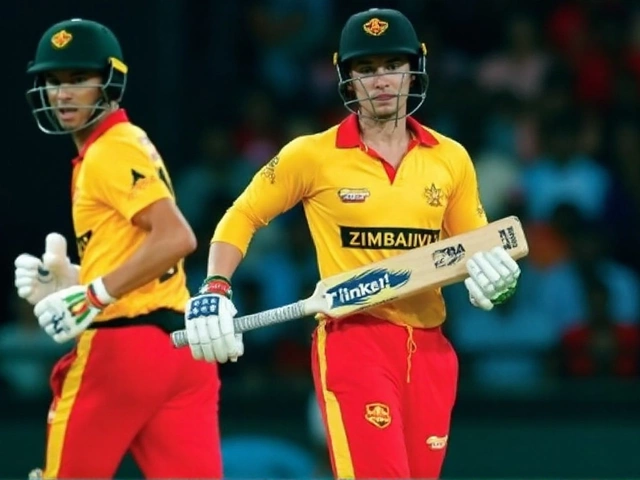By Arvind
The series decider lived up to the hype. Sri Lanka mowed down 192 with 14 balls to spare at Harare Sports Club on September 7, 2025, wrapping up the T20I contest 2-1 with a commanding eight-wicket win. It was the second high-scoring chase of the week and a sharp turn from the low-scoring chaos of the second match—an ebb and flow that kept this tour compelling right to the finish.
Series decider: how Sri Lanka controlled the chase
Batting first, Zimbabwe put up 191/8, a total that usually tests touring sides under lights in Harare. Tadiwanashe Marumani’s 51 off 44 anchored the innings, and captain Sikandar Raza’s 28 off 18 injected the tempo Zimbabwe needed through the middle overs. But Sri Lanka answered with something better-organized and far more ruthless: a top-order masterclass that took the sting out of the target early and never let it recover.
Kamil Mishara was the standout. The left-hander finished 73 not out off 43 balls, striking at just under 170 and pacing the innings like a seasoned finisher rather than a youngster still carving out his place. He picked his match-ups smartly—going hard when length drifted and knocking singles into the big pockets when Zimbabwe tried to drag it back. Kusal Perera set the tone with 46 off 26, the kind of brisk start that flips a required rate from risky to comfortable within a handful of overs.
By the time Zimbabwe found a foothold—Raza’s disciplined four overs for 29 and a neat 1/28 from Brad Evans—they were already behind the game. Sri Lanka finished at 193/2 in 17.4 overs, cruising at a run rate a touch above 10.9. That’s the blueprint in modern T20: stack the powerplay, protect the middle, and leave minimal work for the closing stretch. Mishara and Perera nailed every part of it.
There was a quieter hero too. Sri Lanka’s bowlers had to keep Zimbabwe from pushing past 200, and they did just enough at both ends. Dushan Hemantha’s 3/38 was a momentum check on a surface that didn’t offer a lot of grip. He struck when Zimbabwe were threatening to break away, and those wickets mattered when Sri Lanka planned the chase. Dushmantha Chameera added 2/33—new ball nip, old ball discipline—and kept a lid on Zimbabwe’s late-innings surge.
Zimbabwe’s batting, to its credit, kept intent high. Marumani’s half-century was measured rather than manic, a 51 off 44 that gave others room to swing. Raza, as always, found pockets to score and forced field changes. But in the end, a couple more boundaries at the death might have changed the mood of Sri Lanka’s pursuit. The total was competitive; it just wasn’t untouchable.

What swung the series—and what it means
This series had extremes. In the opener, Sri Lanka hunted down 176 with six wickets in hand. In the second game, Zimbabwe turned a modest 81 into a defendable score by ripping through Sri Lanka for 80. Then came this decider: a return to high-scoring cricket where control of the first ten overs decided almost everything. The contrasts point to two things—conditions that shifted across the week, and tactical choices that either matched those shifts or missed them.
Sri Lanka adjusted faster. After the collapse in the second T20I, they doubled down on clarity at the top of the order. Perera’s aggression reset the tone; Mishara’s shot selection kept risk low while still keeping the board moving. Their partnership—solid, direct, and largely chance-free—removed the need for a late-innings dash. That’s smart T20 batting on a ground with short square boundaries and big straights: work the angles, hit on merit, and don’t let the asking rate breathe.
Zimbabwe will look back at the bowling powerplay and the overs 7–12. That’s where the game slipped. Raza’s spell was tight, Evans hit the right lengths, but the pressure at the other end didn’t always match. In T20, you need paired pressure—back-to-back overs where batters feel boxed in. Zimbabwe got parts of that, never a full squeeze.
On the bowling ledger, Sri Lanka found role clarity. Hemantha’s leg-spin brought wickets rather than just containment—a big deal on a day where singles were easy. Chameera’s Player of the Series award sums up his week: he took important wickets, set fields to his plans, and rarely gave away freebies. In short series, that kind of consistency tilts the coin toss of momentum firmly your way.
The numbers tell their own story. Mishara’s 73 off 43 lands him a strike rate near 170; Perera’s 46 off 26 sits in the mid-170s. Zimbabwe’s best batting rate came from Raza, who pushed at better than 150, but the anchor role—Marumani’s 51 off 44—couldn’t transform into a decisive final push. Meanwhile, Sri Lanka’s chase rate of 10.9 per over made a 190-plus target feel routine. That’s a gulf in execution more than talent.
Zoom out, and the stakes make sense. Sri Lanka had already swept the ODIs 2-0 on this tour, so this T20I win caps a tidy all-format visit. More importantly, there’s the runway to the 2026 T20 World Cup, which Sri Lanka co-host with India. Establishing a stable opening template and building a bowling core around pace and leg-spin is the right kind of homework in 2025.
Zimbabwe didn’t leave empty-handed. That remarkable defense in the second T20I showed grit and discipline that can win qualifiers and tight league games. Marumani getting runs in a series decider is a tick. Raza’s economy and leadership remain the spine of the team. What needs work is the repeatability of death bowling and the pairing of control overs through the middle. On days like this one in Harare, those small gaps turn into big margins.
A quick snapshot of the decider:
- Zimbabwe 191/8 (20 overs): Marumani 51 (44), Raza 28 (18); Hemantha 3/38, Chameera 2/33
- Sri Lanka 193/2 (17.4 overs): Mishara 73* (43), Perera 46 (26); Raza 1/29, Evans 1/28
- Result: Sri Lanka won by 8 wickets; series 2-1
- Player of the Match: Kamil Mishara
- Player of the Series: Dushmantha Chameera
Call it a reality check for both sides. Sri Lanka exit with a clearer idea of their top-order shape and bowling roles. Zimbabwe know they can scrap hard—and now they know exactly where the gaps show up against a confident chase. As far as September cricket goes, this was sharp, watchable, and revealing.
One last thing for the archives: this decider sat at the midpoint of the series narrative. Game one said Sri Lanka could chase. Game two said Zimbabwe could squeeze. The finale said the smarter, calmer batting unit wins more often than not—especially in a fixture like Sri Lanka vs Zimbabwe where momentum flips quickly and the boundary lines tempt you into mistakes.


